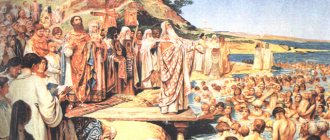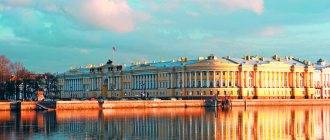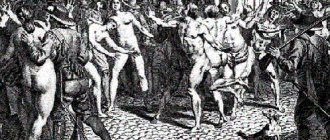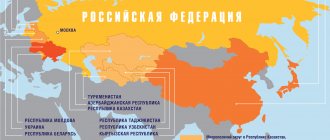Strengthening the economic base of the church in the 6th–11th centuries
The Church managed to preserve and increase its possessions during the barbarian invasions. She contributed to the process of feudalization, playing a significant role in it. In the early Middle Ages in the countries of Western Europe, a significant part of the land was concentrated in the hands of bishops, monasteries, and cathedral chapters; the church exploited the labor of peasants. Church feudal lords occupied a prominent place in the emerging feudal hierarchy. Being vassals of secular sovereigns, they had numerous both spiritual and secular vassals. Large church feudal lords had broad immunity rights. To strengthen social and economic influence, the church used monasteries. Monasteries were already the center of economic life in the 7th-8th centuries - fairs were held next to them, and extensive farming was carried out on the lands they owned. As they grew richer, they expanded their economic activities even more widely, increasing their holdings at the expense of the impoverished communities and through the development of swamps, forests and wastelands. The largest monasteries influenced the political life of Western Europe.
Finished works on a similar topic
Course work Church and state in medieval Europe 490 ₽ Essay Church and state in medieval Europe 250 ₽ Examination Church and state in medieval Europe 250 ₽
Get completed work or advice from a specialist on your educational project Find out the cost
The church acquired the character of a centralized and hierarchical organization. The lowest unit of church organization was the parish, headed by the parish priest. The presbyters were part of a hierarchy headed by the bishop. The bishop, who became the head of the “community of believers” of the diocese, acquired special significance. The Bishop of Rome, the Pope, received special recognition.
The emergence of the papacy played a major role in strengthening the church. At the beginning of the 5th century, the Roman bishops arrogated to themselves the right to be called the head of the church. The popes justified their claim to the supremacy by the fact that they were the “successors of Peter,” who was the first bishop in Rome. Taking advantage of the lack of strong secular power in Italy, in the 5th-6th centuries the popes rose to the occasion, effectively becoming the secular rulers of their diocese.
Section III. Fourth period of Christian history (1453 - present)
The Jerusalem Church is the cradle of Christianity, the mother of all Churches. The first bishop of Jerusalem was the holy Apostle James, brother of the Lord, who here ended his life as a martyr. But the exceptionally difficult situation of Jerusalem and the disasters that befell this city since the first centuries of Christianity were the reason that the Jerusalem Church does not occupy its rightful place among other Churches. The First Ecumenical Council recognized the rights of the regional metropolitan for the Bishop of Jerusalem. The Fourth Ecumenical Council (451) crowned the Bishop of Jerusalem with the rank of Patriarch, calling Jerusalem “The Metropolis of the King of Ages and the cradle of Christianity.” The Sixth Ecumenical Council recognized the Patriarch of Jerusalem as fifth among other Patriarchs, and after the division of the Churches, the Patriarchate of Jerusalem took fourth place in the diptych of Local Orthodox Churches.
The history of the Patriarchate of Jerusalem has much in common with the history of the Patriarchate of Antioch. The flourishing times of the Jerusalem Church also passed in the 7th century, when it was defeated by the Muslim Arabs. Its disasters were completed by the Seljuk Turks (1076), and then by the Crusaders with the forcible imposition of Latinism here and the displacement of Orthodoxy. The rule of the Seljuk Turks was replaced in the 15th century by the rule of the Ottoman Turks. The Turkish administration, as elsewhere, burdened the Christian population with various kinds of exactions. The Christian shrines of Jerusalem and its environs, visited by hundreds of thousands of pilgrims from all over the Christian world, became a gold mine for the Turkish administration. The administration of the Patriarch of Jerusalem alone at the beginning of the 19th century had to pay up to 300 thousand liras to the local Turkish administration and various influential persons.
The Patriarchate of Jerusalem experienced particularly difficult times during the uprising of the Morean Greeks (1821). Persecution was organized against Christians with all its consequences. Bishops and monks were subject to such indemnities that in order to pay them they had to convert church silver into bullion. The leadership of the Patriarchate itself converted up to two thousand pounds of church silver and up to forty pounds of gold into bullion, including lamps and vessels donated to the Holy Sepulcher by the Byzantine emperors and, in addition, found itself in enormous debts, which there were no funds to cover. Its creditors - Muslims and non-believers - demanded that buildings belonging to the Patriarchate and its shrines be sold to pay off debts. The impoverishment of the Patriarchate was so serious that its clergy - bishops and monks - ate only bread and olives.
The position of the Patriarchate and the Christian population of Palestine in general changed for the better when Egyptian rule was established in Palestine (1833). The new ruler of Palestine, Ibrahim Pasha, showed generosity and justice towards Christians. He abolished illegal taxes and levies on Christians and various church institutions, and the execution of his orders was carried out with extraordinary severity and severity towards disobedient people. Such orders remained in Palestine even after the restoration of the power of the Sultan here (1841) thanks to the petition of the Russian embassy to the Porte.
The development of church life was hampered in the Patriarchate by the dependence of Jerusalem on the Patriarchate of Constantinople. Since the middle of the 16th century, the Patriarchs of Jerusalem were not only elected from among the Greeks, but the election itself took place in Constantinople. Until the death in 1534 of the Patriarch of Jerusalem Dorotheus, an Arab by nationality, the Patriarchal and episcopal sees were occupied by both Greeks and Arabs. With the election of the Greek Herman to the Patriarchal throne in 1534, all departments began to be replaced by Greeks. Patriarch Herman legalized the procedure for replacing cathedras by the Greek episcopate. The Greek Patriarchs did not become shepherds of the Jerusalem Church and preferred to live in Constantinople. For two centuries, Jerusalem rarely saw Patriarchs within its walls.
Taking advantage of this situation, the Patriarch of Constantinople intended to completely destroy the independence of the Jerusalem Church and turn it into one of his dioceses. But in 1845, under the influence of Russia, Kirill II was elected Patriarch of Jerusalem and began to reside here permanently. From that time to this day, Jerusalem became a real, and not nominal, cathedral city of its Patriarchs. At the same time, church life in the Patriarchate took a calmer course. In the gloomy history of the Eastern Church, attention is drawn to the widespread propaganda activities of Protestantism and especially the papacy, which did not lose hopes of subjugating the Orthodox East even after the fall of Constantinople. In 1577, a Greek college was opened in Rome, the purpose of which was to train missionaries for Catholic propaganda in the Greek East.
A characteristic moment in the history of the papacy in the Orthodox East is its struggle for possession of holy places. The fight with the Latins over holy places cost the Patriarch of Jerusalem a lot of money, because it gave the Turks the opportunity to make these places the subject of bargaining. However, the Greek Church steadfastly repulsed the attacks of power-hungry Rome, but Catholicism managed to achieve some success in Palestine. By the middle of the 19th century, there were already thousands of Roman Catholics in the Holy Land. In 1846, the Latin Patriarchate of Jerusalem, which existed under the Crusaders, was restored here, having large funds. In 1900, the Latins had 23 monasteries, 62 temples, 71 lower schools, 21 secondary and 2 higher schools in Palestine. The union also developed great activity in the Holy Land.
Simultaneously with Latinism, Protestantism was engaged in intensified missionary activity. Up to 300 different Protestant communities worked in this field in Palestine. Having large resources at its disposal, heterodoxy constantly sought to take away the right to own holy places from the Jerusalem Church. Catholics especially sought this. Thanks to the greed of Turkish officials, these harassments were successful. For example, at the beginning of the 17th century, the Latins, having received access, with the permission of the Jerusalem Patriarchate, to the Church of the Resurrection, without performing divine services there, managed to achieve not only this right, but by bribing the Turkish authorities, they captured Golgotha, part of the Bethlehem Temple and received permission to perform divine services in the cave Christmas. The ruling Patriarch Sophronius V (1579–1608) had to make a lot of efforts to obtain a firman from the Sultan, which stated that “Golgotha is the property of the Romans.”
In the 19th century, even the diplomacy of European countries intervened in this struggle, which, despite the protection of the rights of the Jerusalem Church by Russia, achieved some privileges to holy places for heterodoxy. The Church of Jerusalem, in the person of its Patriarchs and the Holy Sepulcher brotherhood, sparing neither money nor effort, steadily defended for the entire Orthodox Church its rights to own the Gospel places. The history of the Patriarchs of Jerusalem during the period described presents us with the history of the struggle with the Latins and other infidels for the possession of holy places in Palestine; their life was spent in constant travel from Jerusalem to Constantinople and back, as well as throughout all Orthodox countries. In Jerusalem and Constantinople, with greater energy and persistence, they defended the rights of Orthodoxy to the ownership of holy places before the Turkish government, suppressing the machinations of the Gentiles, mainly Latins, and in Orthodox countries - Russia, Moldova, Wallachia, Georgia - they tirelessly collected funds to maintain this ownership.
Patriarchs Theophan (1607–1644), Paisiy (1644–1661) and Dosifei (1669–1707) were distinguished by particularly difficult and frequent travels for these purposes. Of the Jerusalem Patriarchs of the second half of the 19th century, Patriarch Kirill II (1845–1872) attracts attention as an educated and active archpastor for the benefit of Orthodoxy. Having made Jerusalem his permanent residence, he turned all his attention to the improvement of his Patriarchate - he restored churches in his Patriarchal district, rebuilt the ancient destroyed churches in Lydda and Mount Tabor, founded a theological school for training priests and folk teachers from the natives, opened several folk schools, established a hospital, a printing house, etc. in Jerusalem. During the dramatic feud between the Patriarch of Constantinople and the Bulgarians, Cyril II in 1872 refused to sign the excommunication of the Bulgarian bishops, and for this, under the influence of the Patriarchate of Constantinople, in the same year he was his Jerusalem bishops deposed from the pulpit.
In 1917, all of Palestine was occupied by England, whose protectorate over all of Palestine was recognized in 1920 by the League of Nations. In 1947, the British government announced its agreement to refer the Palestinian question to the United Nations. The delegation of the Soviet Union proposed eliminating the British Mandate over Palestine and creating a binational Arab-Jewish democratic state in Palestine. In accordance with the decision of the UN General Assembly in 1948, the Jewish state of Israel was formed on part of the territory of Palestine. True, it was not a democratic state.
Immediately after the formation of the new state, a war began between Israel, on the one hand, and seven Arab states members of the Arab League - Egypt, Iraq, Saudi Arabia, Syria, Lebanon, Transjordan and Yemen - on the other. In 1949, a truce was concluded between the troops of Israel and the Arab states. The Arab part of Palestine was occupied by the troops of Transjordan and at the same time the annexation of the part of Palestine occupied by it to Transjordan was announced. Neither the Arabs nor the Israelis wanted to give up the city of Jerusalem, and therefore most of the so-called. The new city of Jerusalem remained in the hands of the State of Israel, the so-called. The old city is in the hands of Jordan, where the residence of the Patriarch is now located. In 1967, the eastern part of the city was annexed by Israel.
Currently, the Patriarchate of Jerusalem consists of two metropolises and one archbishopric with a flock of about 80 thousand people - Arabs and Greeks living in Jordan, Israel and Palestine, where there are 55 parishes, 23 churches and 27 monasteries. The spiritual jurisdiction of the Patriarch of Jerusalem also includes the Holy Mount Sinai with its archdiocese, metochions in Athens (Greece), Istanbul (Turkey) and Nicosia (Cyprus). Previously, diocesan bishops almost all lived at the residence of the Patriarch and rarely saw their flock, and others did not even know the volume or boundaries of their dioceses. This was a consequence of the extreme poverty of the dioceses, which could not support their bishops and their small staff. Currently, their situation has changed for the better. They began to frequently visit their dioceses, and many even live permanently in their diocesan cities, such as the Metropolitans of Ptolemais and Nazareth.
The management of the Patriarchate is concentrated in the hands of the Patriarch and the Synod existing under him, consisting of 14 bishops of the 18th Church of Jerusalem and the oldest archimandrites - members of the brotherhood of the Monastery of the Holy Sepulcher. The Patriarch is elected by the Synod. The Patriarch of Jerusalem has large monetary incomes from estates assigned to the Holy Sepulchre, farmsteads and pilgrims. From its funds, the Church supports not only the Patriarch, but also metropolitans, monasteries, schools, hospitals, parish clergy, the poor and orphans. In Palestine, together with the monastic ones, there were about 100 churches. There are about 22 monasteries in the Patriarchate (17 male and 5 female).
The Holy Sepulchre Monastery, whose abbot is the Patriarch, is of great importance. The Holy Sepulcher Monastery has the appearance of a town with streets, gardens, houses and temples. Here is the residence of the Patriarch, where he and the members of the Synod, the institution of the Patriarchate, are located. Only persons who devote themselves entirely to the service of the Jerusalem Church and prepare themselves here for the highest hierarchical service are accepted into the brotherhood. The Holy Sepulcher Brotherhood, founded in the 4th century, is an authoritative spiritual and moral force and takes part in church governance, subordinating the Patriarch himself to its influence. It has up to 200 inhabitants. The Brotherhood publishes the magazine “New Zion”.
Great disasters in the past did not allow the Patriarchate of Jerusalem to focus on spiritual enlightenment. There were no material resources either. The flock nurtured their spirit and forged their faith mainly through difficult trials. However, the Patriarchs of Jerusalem did their best to educate the clergy and people, inviting didaskals (teachers) from Byzantium and opening schools. Currently, the Church runs 9 charitable societies and institutions, 6 primary schools and gymnasiums. Outside of Israel, the Church of Jerusalem extends its jurisdiction to Jordan and the Sinai Peninsula (Egypt), where the autonomous Sinai Archdiocese is located. In Athens (Greece), Istanbul (Turkey) and Nicosia (Cyprus), several churches and farmsteads are subordinate to the Church, which are managed by the Patriarchal Epitropes. Members of the clergy of the Holy Land who wish to receive higher theological education use the theological schools of the Patriarchate of Constantinople.
Patriarchate of Jerusalem - Holy Land. Here are the greatest shrines of the entire Christian world - the Church of the Holy Sepulcher and the Resurrection, as well as the holy places where the founder of Christianity, Jesus Christ, was born, lived and preached, suffered and ascended to heaven. The Holy Sepulcher is a cave about two meters long and wide, and the very place where Christ reclined is a stone ledge made of rock two meters long, about 70 cm wide. The Body of Jesus, wrapped in a shroud, was laid on this stone block. Now this stone is covered with marble on top, divided into three parts that serve as thrones during the liturgy: the middle part for the Orthodox, the right part for the Armenians and the left, western, for Catholics. The entrance to the tomb cave is very narrow and low, its height is 1 m and 25 cm, its width is a little more than half a meter. Above the cave rises a pentagonal chapel, the cuvuklia, which is located inside the Church of the Resurrection of Christ.
Inside the Church of the Resurrection there is also Golgotha, towering over the entire western part of the temple. The Calvary Church flaunts here. Above the place where the Life-Giving Cross was erected, there is an open throne belonging to the Orthodox and Armenians.
Shortly after his election to the Patriarchal Throne, His Holiness Patriarch Alexy II of Moscow and All Rus' visited the Holy Land in 1991 at the head of a large group of pilgrims.
Title of the Primate of the Church of Jerusalem: Blessed Patriarch of the Holy City of Jerusalem and All Palestine.
The patriarchal residence is located in Jerusalem.
Union between church and state
Note 1
In general, there was an alliance between church and state during the early Middle Ages.
In the fight against the enemies of this union, as well as against those who encroached on the authority of the church, she used a system of church punishments:
Are you an expert in this subject area? We invite you to become the author of the Directory Working Conditions
- “excommunication,” which placed a person outside the church;
- an “interdict” that prohibited the practice of worship on the territory of a region or an entire country;
- “anathema” - condemnation;
- church repentance.
Note 2
For the people of that time, these measures were as terrible as the punishments imposed by the secular authorities.
The early feudal state defended the interests of the church. Pepin the Short participated in the creation of the Papal State. Charlemagne legalized church tithes as obligatory taxes.
The influence of the church was determined not only by its alliance with the state and wealth, but also by the monopoly it had in intellectual life. School education, literature, and the copying of books were concentrated in the hands of the church; the selection and preservation of elements of the ancient tradition depended on it. All educated people, writers, poets, historians, teachers came from the ranks of the clergy.
Coptic Church
1 / 2
Saint Christopher. 1685 Byzantine and Christian Museum, Athens Getty Images
2 / 2
Anubis. Illustration from A Traveler's Guide to Lower and Upper Egypt. 1888 Wikimedia Commons
Copts are the name given to the descendants of the ancient Egyptians who converted to Christianity. According to church tradition, the first preacher of the new faith in the Land of the Pharaohs was the author of one of the Gospels, the Apostle Mark. By the beginning of the 4th century, a significant part of the indigenous population of Egypt professed Christianity and fought against the pagans: they destroyed Egyptian temples, smashed statues of gods, and mocked ancient customs. One of the stories that has come down to us tells how a certain monk spent the night in a tomb, and instead of a pillow he put a mummy under his head.
However, the new Christian culture not only mocked the heritage of its ancestors, but also creatively reworked it. The symbol of this synthesis is the image of the Christian Saint Christopher - cynocephalus (dog-headed). According to one version of the legend, the Christian youth Christopher was so handsome that women, absorbed in the contemplation of his appearance, did not hear a word of his sermon. Then Christopher asked God to deprive him of his beauty, as a result of which he became a dog-head. Art historians believe that the iconography of this saint was influenced by the image of the god Anubis with the head of a jackal. And the images of Isis - the goddess of fertility, a symbol of femininity and motherhood - holding her son in her arms influenced the iconography of the Mother of God with the Child Jesus. Some ancient Egyptian symbols received a new interpretation: the sign of life ankh was reinterpreted as a cross; images of fish - as a symbol of Jesus Christ. The synthesis of Christianity and the religion of Ancient Egypt is most clearly manifested in texts related to magical conspiracies and continuing ancient Egyptian magical practices. “Hor, Horus, For, Eloe, Adonai, Iao, Hosts, Michael, Jesus Christ! Help us and this house. Amen” - in this prayer, not only Christ and Christian saints are called to help, but also the Egyptian gods and even the Jewish Host (there was a fairly significant Jewish community in Egypt). These conspiracies had different purposes - to bewitch a girl, destroy an enemy, or neutralize an evil dog.
Most Coptic temples take the form of a basilica and are usually topped by a dome or rows of identical domes. The interior decoration of the temple includes paintings, icons and carpets - you are required to take off your shoes when entering the temple. This tradition probably arose under the influence of the Muslim environment: it is also customary to enter a mosque without shoes. One of the most popular Coptic saints is St. George; there is a throne in his honor or an icon in every Coptic temple.
Political and social prerequisites for the rise of the papacy in the 12th-13th centuries
In the XII-XIII centuries, the influence of the Catholic Church increased. This process is associated with the fact that most European countries were in a state of feudal fragmentation. In the absence of strong states, the church, which strengthened its power, turned out to be the only force whose authority was recognized in all countries.
The papacy used feudal fragmentation to its own advantage. Its support in certain countries were bishops and monasteries, which had broad immunity privileges. But at the same time being vassals of the king of the country and the pope, in different periods they occupied different positions. Many supported the strengthening of central power and therefore did not sympathize with the theocratic claims of the papacy; others zealously pursued papal policy, preventing the strengthening of central power and supporting feudal-separatist protests.
In the 12th-13th centuries, the papacy used all political events to increase its influence. It acted as the organizer of the crusades in the East; gave the Reconquista a religious character; sanctified the predatory campaigns of knights against the Baltic and Slavic peoples. The papacy participated in the suppression of anti-feudal movements. The political influence of the church relied on the financial power of the Roman Curia. Significant sums of money flowed here every year. Having financial resources that exceeded those of secular sovereigns, the popes could actively pursue their foreign policy. The strengthening of the church and the papacy was facilitated by the fact that it retained power over the ideological life of society.
The 13th century was the time of the highest international influence of the papacy. Pope Innocent III (1198-1216) defended the idea of the supremacy of church power over secular power and laid claim to world domination. He restored the possessions of the church in the Papal States and expanded its borders; he was at one time the ruler of the Kingdom of Sicily. He attached importance to the papal curia as the highest court of justice in the Catholic world. The king of England, John the Landless, and the kings of Aragon and Portugal recognized themselves as his vassals. The successors of Innocent III interfered in the internal affairs of the states of Western Europe, claiming the role of a pan-European arbiter.
Boniface VIII sought to implement the ideas of papal theocracy. In 1302 he issued the bull "Unam sanctam", in which the final clause read:
“The submission of every human creature to the Roman high priest is an indispensable condition of salvation.”
Papal power was declared the highest authority. However, the claims of the popes were not put into practice, since this policy was in conflict with the processes of centralization of national states - England, France, etc.
Syriac Orthodox Church
Ignatius Ilia III (center), Patriarch of Antioch and all the East. Jerusalem, 1920s In 1987, 55 years after his death, he was canonized by the Syrian Orthodox Church.
Bridgeman Images / Fotodom Christianity spread and took hold in Syria very early. The New Testament tells that on the road to the Syrian city of Damascus, the resurrected Jesus Christ appeared to the Apostle Paul; in Damascus, Paul was healed of the blindness that had struck him and baptized. This is where his missionary work began.
In the Syrian city of Antioch, followers of Jesus Christ first began to call themselves Christians. There is a popular legend among Syrian Christians that the East Syrian kingdom of Osroene became Christian back in the 1st century, and its ruler, King Abgar, was in correspondence with Jesus Christ and even invited him to move to the capital of Osroene, Edessa: “My city is very small, but venerable, and It’s enough for both of us.”
An important role in the spread of Christianity among the Syrians was played by the fact that Jesus and his disciples, in fact, spoke Aramaic, one of the dialects of which is Syriac. In the 4th century, the Bible was translated into Syriac. This translation is called the Peshitta (in Syriac it means “generally accepted text”) and is the official Holy Scripture of the Syro-Jacobites (more about them below).
The refusal of some Syrians to accept the decisions of the Council of Chalcedon subsequently led to a split in Syriac Christianity. The Syrians, who agreed with the decisions of the council and thereby showed loyalty to the Byzantine emperor, began to be called Melkites - “royal”, and their opponents - Jacobites, named after Bishop Jacob Baradai, who in the 6th century led the opponents of Chalcedon and created an independent church hierarchy. An energetic organizer, Jacob was an ascetic: his nickname Baradai (“felt”) refers to the fact that he wore a hair shirt on his body.
In the Syro-Jacobite Church, sourdough bread is used for communion: according to legend, it has been passed down from generation to generation since apostolic times. It is interesting that the Syro-Jacobites (like the Copts) make the sign of the cross with one finger - from left to right, clearly affirming the unity of the nature of Jesus Christ.
Missionary activity of Christians in Western Europe
The Roman community and its bishop, the Pope, set a course for gradually strengthening their positions. They sent their missionary priests to the barbarian kingdoms, who encouraged the new settlers to accept Christianity. These calls found a response among the subjects of the new kingdoms who studied with the descendants of Roman settlers, who, by the way, were noticeably numerically inferior to the colonists. The Christianization of yesterday's barbarians proceeded quite quickly.
The Franks, for example, adopted a new religion as early as 496. Having borrowed the foundations of Christianity from the Romans - sometimes in the form of early heresies, mainly Arianism, which has already been discussed (this applies primarily to the Visigoths and Lombards), - the population that replaced the Western Roman Empire kingdoms, along with a developed religious system, perceived many elements of a closely related culture. This is not surprising. After all, calls to accept a new religion were reinforced by the construction of churches in which rituals were regularly performed and numerous services were held, which had an emotional impact on temple visitors.
The construction of churches and monasteries and their active influence on the new settlers, who quickly forgot their pagan gods and actively became involved in the new spiritual culture and the ideas preached by its adherents, did their job. In this regard, it is impossible not to note the enormous role of the just mentioned church services with all their solemn and colorful rituals. These services made a huge impression on the converts, as did those majestic cathedrals in which the most significant of the rites were performed and which very clearly symbolized the connection of the earthly principle with the divine. And although many of them took centuries to build - and perhaps that is why - they were often perceived not only as a masterpiece of architecture, but also as another man-made miracle placed at the service of religion and the church.








